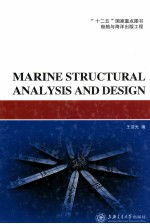

船舶与海洋结构物结构设计与分析 英文版PDF电子书下载
- 电子书积分:10 积分如何计算积分?
- 作 者:王迎光编
- 出 版 社:上海:上海交通大学出版社
- 出版年份:2013
- ISBN:9787313098696
- 页数:220 页
Chapter 1 Introduction to marine structural design 1
1.1 The traditional design method 1
1.1.1 The evolutionary process 1
1.1.2 A ship structural design example 1
1.1.3 The changes to the traditional design method 4
1.2 The modern design method 5
1.2.1 The first-principles-based approach 5
1.2.2 The design procedure 6
1.2.3 Benefits of the modern approach 9
Chapter 2 Marine structural design fundamentals 11
2.1 Structural arrangements design 11
2.1.1 Subdivision arrangement 11
2.1.2 Compartment arrangement 12
2.1.3 Access arrangement 13
2.2 Structural materials 14
2.2.1 Introduction to materials 14
2.2.2 Standard steels used for hull and other structure 16
2.2.3 High strength steel used for hull and other structures 19
2.2.4 Selection for steel grades 21
2.2.5 Other ship materials 22
2.2.6 An example of ship materials used for a dredging barge 24
2.3 Welding 26
2.3.1 The base types of welding joints 26
2.3.2 The base types of welding line 28
2.3.3 Stud welding 28
2.3.4 The determination of the weld size 30
2.3.5 A welding design example 35
2.4 Classification societies and their rules 37
2.4.1 Classification societies 37
2.4.2 Class rules,regulationsand guides 41
Chapter 3 Loads and loads combinations 52
3.1 EnvironmentaI considerations 52
3.2 Loads 52
3.2.1 Static loads 53
3.2.2 The wave induced loads 54
3.2.3 The hydrodynamic loads 57
3.2.4 The sloshing loads 57
3.2.5 The impact loads 58
3.2.6 Other loads types 58
3.3 Loads combinations 59
3.4 Strength modeling and development of strength criteria 60
Chapter 4 Marine structural initial design 63
4.1 Hull girder strength and shearing strength 63
4.2 Hull structural members design 66
4.2.1 Plating design 66
4.2.2 Longitudinals and girders design 68
4.2.3 Bulkhead design 71
4.3 An example of hull structural members design-pillar design 74
4.3.1 Basic design of pillars 74
4.3.2 Some requirements for the pillars in rules 86
4.3.3 Regulations of pillars on different types of ships 94
4.4 Superstructure design 95
4.4.1 The interaction between the superstructure and the main hull 95
4.4.2 The design of superstructures 100
4.4.3 The failure of superstructures and prevention measures 105
4.5 Introduction to structures of various kinds of ships 107
4.5.1 Oil tankers 107
4.5.2 Bulk carriers 117
4.5.3 Container ships 138
Chapter 5 Marine structural design analysis 145
5.1 Total strength assessment 145
5.1.1 Yielding strength 145
5.1.2 Buckling and ultimate strength 145
5.1.3 Fatigue strength 146
5.2 Strength criteria 147
5.2.1 General introduction 147
5.2.2 Yielding criteria 148
5.2.3 Buckling and ultimate strength criteria 149
5.2.4 Fatigue criteria 152
5.3 Finite element analysis(FEA) 154
5.3.1 The developmental history of the finite element analysis 154
5.3.2 The basic idea of the finite element method 155
5.3.3 A finite element analysis example—a 75,000 DWT bulk carrier 158
5.4 Spectral fatigue analysis of ship structures 166
5.5 The transverse strength analysis of a ship 179
Chapter 6 Marine structural design optimization 184
6.1 The introduction to the optimization 184
6.2 The categorization methods for optimization problems 185
6.2.1 Continuous versus discrete optimization 185
6.2.2 Constrained and unconstrained optimization 186
6.2.3 Global and local optimization 187
6.2.4 Deterministic and stochastic optimization 187
6.3 An example—the optimization of stiffened panels 188
6.3.1 Introduction to stiffened plates 188
6.3.2 The numerical solution method for a stiffened panel 189
6.3.3 Summarization 207
6.4 Another example—the optimization of a T-bar 207
6.4.1 The problem raised and the model established 207
6.4.2 Analytical solution method 210
6.4.3 Finite Element Analysis solution method 212
6.4.4 Comments on each solution method 215
References 217
- 《联吡啶基钌光敏染料的结构与性能的理论研究》李明霞 2019
- 《异质性条件下技术创新最优市场结构研究 以中国高技术产业为例》千慧雄 2019
- 《指向核心素养 北京十一学校名师教学设计 英语 七年级 上 配人教版》周志英总主编 2019
- 《设计十六日 国内外美术院校报考攻略》沈海泯著 2018
- 《卓有成效的管理者 中英文双语版》(美)彼得·德鲁克许是祥译;那国毅审校 2019
- 《计算机辅助平面设计》吴轶博主编 2019
- 《高校转型发展系列教材 素描基础与设计》施猛责任编辑;(中国)魏伏一,徐红 2019
- 《景观艺术设计》林春水,马俊 2019
- 《高等教育双机械基础课程系列教材 高等学校教材 机械设计课程设计手册 第5版》吴宗泽,罗圣国,高志,李威 2018
- 《指向核心素养 北京十一学校名师教学设计 英语 九年级 上 配人教版》周志英总主编 2019
- 《绝徼移栽桢干质》龙美光编 2018
- 《机械制造基础》米国际,王迎晖主编;沈景祥,黄伟,王祯,秦明伟副主编 2019
- 《笳吹弦诵在山城》龙美光编 2018
- 《国际结算》王迎,韩晶玉主编 2014
- 《中国名联选》张鲁光编 1992
- 《教育科学纲要》罗廷光编 1935
- 《麻辣科学 “可怕”的科学》李莹主编;刘行光编 2013
- 《中述华园》杜小明,王迎军主编;李琳,刘琪瑾,张振刚副主编 2012
- 《华语电影新时代》张思涛主编;王迎庆,吴冠平,陈墨等编 2013
- 《中学中文教学论集 增订本》王培光编 1988
